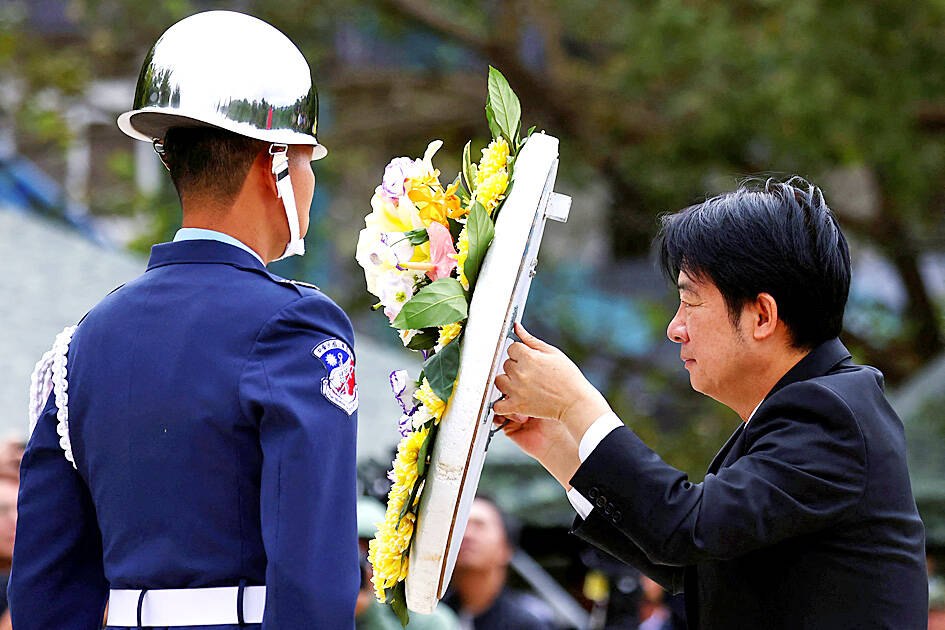Taiwan cherishes its freedom and democracy, and no “external force” can change its future, President William Lai (賴清德) said yesterday while visiting Kinmen County for the 75th anniversary of a key victory over communist forces.
Lai told veterans and family members that the October 1949 Battle of Guningtou, when Chinese Nationalist Party (KMT) forces beat off an invasion attempt of Kinmen by the Chinese People’s Liberation Army (PLA), “represents our determination to protect our country.”
“The Battle of Guningtou makes us realize that democracy and freedom are not something to be taken for granted,” Lai said.

Photo: I-Hwa Cheng, AFP
“We treasure a democratic and free way of life, and we cannot, and will not, allow any external force to change the future of Taiwan, Penghu, Kinmen and Matsu, right?” he added.
Lai reiterated his determination to maintain peace and stability and defend Taiwan’s sovereignty, as well as his willingness to talk to Beijing.
“Our insistence on safeguarding a democratic and free lifestyle for generations to come has not changed and will remain unchanged,” he added.

Photo: Annabelle Chih, Reuters
The Kinmen battle was a rare victory for Chiang Kai-shek’s (蔣介石) forces in the final days of China’s civil war.
In December of that year, the KMT government fled to Taiwan and in the following years and months would lose a string of other islands and islets to communist forces.
It was Lai’s second trip to Kinmen since he took office in May.

Photo: CNA
The visit comes after the army’s Penghu Defense Command held its first-ever nighttime live-fire drills on Thursday aimed at getting the military accustomed to the possibility of an invasion by the PLA in the dark.
The exercise was conducted at the Wude (五德) area in the southern part of the main island in Penghu County.
The entire exercise was performed to simulate the potential actions that would be taken by the PLA in a surprise nighttime invasion, command officials said.
The exercises, which the media were invited to attend, consisted of aerial, naval and land simulations in the dark, officials said.
The land drills featured CM-21 armored vehicles and M60A3 tanks deployed with soldiers armed with weaponry, and they were all equipped with night-vision gear to provide clear views.
Live ammunition was also fired around the beaches in the area to prepare for a possible land attack.
To counter a simulated aerial invasion using uncrewed aerial vehicles, the army deployed flares to light up the night sky to fire 120mm mortars into the air.
Naval simulations involved the possibility that the PLA Navy might penetrate Taiwan’s waters disguised as fishers, the army said, which subsequently involved the firing of ammunition from the land to sea.
Ahead of the drills, the Coast Guard Administration issued a notice to local fishers and boat users warning them there would be a live-fire exercise in the waters near Wude.
The drills were held in 18 locations, and more than 32,000 rounds of different kinds of ammunition were fired.
On what was the most difficult aspect of firing ammunition at night, army officials said it was fighting through sand blown by gusts of wind that were strengthened by seasonal northeasterly winds, as well as the visual challenges brought by nighttime combat.

SECURITY: As China is ‘reshaping’ Hong Kong’s population, Taiwan must raise the eligibility threshold for applications from Hong Kongers, Chiu Chui-cheng said When Hong Kong and Macau citizens apply for residency in Taiwan, it would be under a new category that includes a “national security observation period,” Mainland Affairs Council (MAC) Minister Chiu Chui-cheng (邱垂正) said yesterday. President William Lai (賴清德) on March 13 announced 17 strategies to counter China’s aggression toward Taiwan, including incorporating national security considerations into the review process for residency applications from Hong Kong and Macau citizens. The situation in Hong Kong is constantly changing, Chiu said to media yesterday on the sidelines of the Taipei Technology Run hosted by the Taipei Neihu Technology Park Development Association. With

CARROT AND STICK: While unrelenting in its military threats, China attracted nearly 40,000 Taiwanese to over 400 business events last year Nearly 40,000 Taiwanese last year joined industry events in China, such as conferences and trade fairs, supported by the Chinese government, a study showed yesterday, as Beijing ramps up a charm offensive toward Taipei alongside military pressure. China has long taken a carrot-and-stick approach to Taiwan, threatening it with the prospect of military action while reaching out to those it believes are amenable to Beijing’s point of view. Taiwanese security officials are wary of what they see as Beijing’s influence campaigns to sway public opinion after Taipei and Beijing gradually resumed travel links halted by the COVID-19 pandemic, but the scale of

A US Marine Corps regiment equipped with Naval Strike Missiles (NSM) is set to participate in the upcoming Balikatan 25 exercise in the Luzon Strait, marking the system’s first-ever deployment in the Philippines. US and Philippine officials have separately confirmed that the Navy Marine Expeditionary Ship Interdiction System (NMESIS) — the mobile launch platform for the Naval Strike Missile — would take part in the joint exercise. The missiles are being deployed to “a strategic first island chain chokepoint” in the waters between Taiwan proper and the Philippines, US-based Naval News reported. “The Luzon Strait and Bashi Channel represent a critical access

Pope Francis is be laid to rest on Saturday after lying in state for three days in St Peter’s Basilica, where the faithful are expected to flock to pay their respects to history’s first Latin American pontiff. The cardinals met yesterday in the Vatican’s synod hall to chart the next steps before a conclave begins to choose Francis’ successor, as condolences poured in from around the world. According to current norms, the conclave must begin between May 5 and 10. The cardinals set the funeral for Saturday at 10am in St Peter’s Square, to be celebrated by the dean of the College